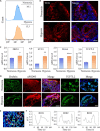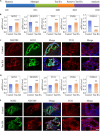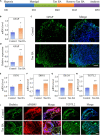Cortical Organoid-on-a-Chip with Physiological Hypoxia for Investigating Tanshinone IIA-Induced Neural Differentiation
- PMID: 38434243
- PMCID: PMC10907018
- DOI: 10.34133/research.0273
Cortical Organoid-on-a-Chip with Physiological Hypoxia for Investigating Tanshinone IIA-Induced Neural Differentiation
Abstract
Cortical organoids represent cutting-edge models for mimic human brain development during the early and even middle stage of pregnancy, while they often fail to recreate the complex microenvironmental factors, such as physiological hypoxia. Herein, to recapitulate fetal brain development, we propose a novel cortical organoid-on-a-chip with physiological hypoxia and further explore the effects of tanshinone IIA (Tan IIA) in neural differentiation. The microfluidic chip was designed with a micropillar array for the controlled and efficient generation of cortical organoids. With low oxygen, the generated cortical organoids could recapitulate key aspects of early-gestational human brain development. Compared to organoids in normoxic culturing condition, the promoted neurogenesis, synaptogenesis and neuronal maturation were observed in the present microsystem, suggesting the significance of physiological hypoxia in cortical development. Based on this model, we have found that Chinese herbal drug Tan IIA could promote neural differentiation and maturation, indicating its potential therapeutic effects on neurodevelopmental disorders as well as congenital neuropsychiatric diseases. These results indicate that the proposed biomimetic cortical organoid-on-a-chip model with physiological hypoxia can offer a promising platform to simulate prenatal environment, explore brain development, and screen natural neuroactive components.
Copyright © 2023 Yue Zhi et al.
Conflict of interest statement
Competing interests: The authors declare that they have no competing interests.
Figures






Similar articles
-
Human brain organoid-on-a-chip to model prenatal nicotine exposure.Lab Chip. 2018 Mar 13;18(6):851-860. doi: 10.1039/c7lc01084b. Lab Chip. 2018. PMID: 29437173
-
Neurodevelopmental impairment induced by prenatal valproic acid exposure shown with the human cortical organoid-on-a-chip model.Microsyst Nanoeng. 2020 Jul 13;6:49. doi: 10.1038/s41378-020-0165-z. eCollection 2020. Microsyst Nanoeng. 2020. PMID: 34567661 Free PMC article.
-
In situ generation of human brain organoids on a micropillar array.Lab Chip. 2017 Aug 22;17(17):2941-2950. doi: 10.1039/c7lc00682a. Lab Chip. 2017. PMID: 28752164
-
Bioengineering tissue morphogenesis and function in human neural organoids.Semin Cell Dev Biol. 2021 Mar;111:52-59. doi: 10.1016/j.semcdb.2020.05.025. Epub 2020 Jun 12. Semin Cell Dev Biol. 2021. PMID: 32540123 Free PMC article. Review.
-
Humanized brain organoids-on-chip integrated with sensors for screening neuronal activity and neurotoxicity.Mikrochim Acta. 2024 Jan 3;191(1):71. doi: 10.1007/s00604-023-06165-4. Mikrochim Acta. 2024. PMID: 38168828 Review.
Cited by
-
Establishment of nasal and olfactory epithelium organoids for unveiling mechanism of tissue regeneration and pathogenesis of nasal diseases.Cell Mol Life Sci. 2025 Jan 3;82(1):33. doi: 10.1007/s00018-024-05557-w. Cell Mol Life Sci. 2025. PMID: 39751829 Free PMC article. Review.
-
Engineering tumor-oxygenated nanomaterials: advancing photodynamic therapy for cancer treatment.Front Bioeng Biotechnol. 2024 Mar 13;12:1383930. doi: 10.3389/fbioe.2024.1383930. eCollection 2024. Front Bioeng Biotechnol. 2024. PMID: 38544975 Free PMC article. Review.
-
Progress of organoid platform in cardiovascular research.Bioact Mater. 2024 Jun 8;40:88-103. doi: 10.1016/j.bioactmat.2024.05.043. eCollection 2024 Oct. Bioact Mater. 2024. PMID: 38962658 Free PMC article. Review.
-
Advances in humanoid organoid-based research on inter-organ communications during cardiac organogenesis and cardiovascular diseases.J Transl Med. 2025 Mar 28;23(1):380. doi: 10.1186/s12967-025-06381-x. J Transl Med. 2025. PMID: 40156006 Free PMC article. Review.
-
Isoliquiritigenin Promotes the Repair of High Uric Acid-Induced Vascular Injuries.Smart Med. 2025 Apr 4;4(2):e70000. doi: 10.1002/smmd.70000. eCollection 2025 Jun. Smart Med. 2025. PMID: 40303869 Free PMC article.
References
-
- Klingler E, Francis F, Jabaudon D, Cappello S. Mapping the molecular and cellular complexity of cortical malformations. Science. 2021;371(6527):eaba4517. - PubMed
-
- Wang J, Qiao H, Wang Z, Zhao W, Chen T, Li B, Zhu L, Chen S, Gu L, Wu Y, et al. . Rationally design and acoustically assemble human cerebral cortex-like microtissues from hiPSC-derived neural progenitors and neurons. Adv Mater. 2023;35(32):e2210631. - PubMed
-
- Ku T, Ren Z, Yang R, Liu QS, Sang N, Faiola F, Zhou Q, Jiang G. Abnormal neural differentiation in response to graphene quantum dots through histone modification interference. Environ Int. 2022;170: Article 107572. - PubMed
LinkOut - more resources
Full Text Sources

